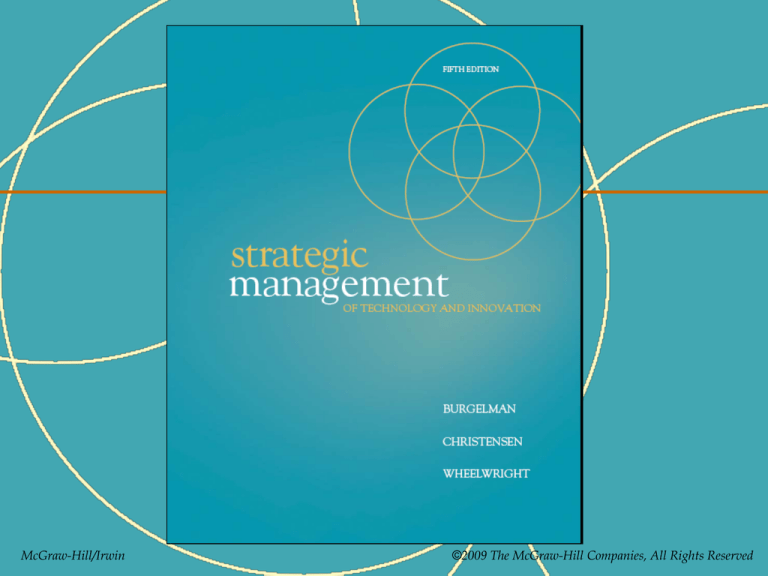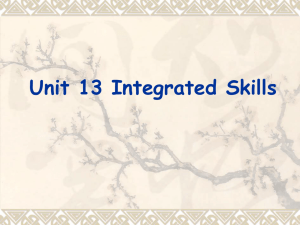
McGraw-Hill/Irwin
©2009 The McGraw-Hill Companies, All Rights Reserved
Part One:
Integrating Technology and Strategy
Chapter One Offers Three Elements
• Key concepts concerning technological innovation
• Elements of the integration of technology with corporate
strategy
• Frameworks for auditing and accessing a firm’s innovative
capability
1-2
Part One:
Integrating Technology and Strategy
Definition of Terms
Invention versus discovery:
• “We discover what before existed, though to us unknown; we
invent what did not before exist.” – Webster
Basic versus applied research:
• Basic research refers to activities involved in generating new
knowledge; applied research is geared to solving particular
technological problems
1-3
Part One:
Integrating Technology and Strategy
Definition of Terms
Technology:
• This refers to the theoretical and practical knowledge, skills
and artifacts that can be used to develop products and services
as well as their production and delivery systems. Technology
can be embodied in people, materials, cognitive and physical
processes, plant, equipment and tools
1-4
Part One:
Integrating Technology and Strategy
Definition of Terms
Technological Innovation:
• This can be technology-based or facilitated by technology.
We define successful technological innovation as that which
returns the original investment plus some additional returns
1-5
Part One:
Integrating Technology and Strategy
Definition of Terms
Innovation process:
• This can be defined as the combined activities leading to new,
marketable products and services and/or new production and
delivery systems
1-6
Part One:
Integrating Technology and Strategy
Definition of Terms
Types of Technological Innovation:
• Incremental innovation: adaptation, refinement and
enhancement of existing products or services
• Radical innovation: entirely new product and service
categories
• Architectural innovation: reconfigurations of the systems or
components that constitute the product
1-7
Part One:
Integrating Technology and Strategy
Technology and Competitive Strategy
Porter’s “generic strategies” concept is a widely used
framework for classifying competitive strategies. The
generic strategies are:
Industrywide differentiation
Focused differentiation
Industrywide cost leadership
Focused cost leadership
1-8
Part One:
Integrating Technology and Strategy
Generic strategy
Overall cost
leadership
Overall
differentiation
Focus-segment cost
leadership
Focus-segment
differentiation
Technological policies
Product technological
change
Product development to
reduce product
cost by lowering
materials content,
facilitating ease of
manufacture,
simplifying
logistical
requirements, etc.
Product development
to enhance
product quality,
features,
deliverability, or
switching costs
Product development
to design only
enough
performance for
the segment's
needs
Product design to
meet exactly the
needs of the
particular
business
segment
application
Process technological
change
Learning curve
process
improvement
Process
development to
enhance
economies of
scale
Process development
to support high
tolerances,
greater quality
control, more
reliable
scheduling, faster
response time to
orders, and other
dimensions that
improve
the ability to perform
Process development
to tune
production and
delivery system
to segment
needs in order to
lower cost
Process development
to tune the
production and
delivery system
to segment need
in order to
improve
performance
1-9
Part One:
Integrating Technology and Strategy
Technology and Product-Market Strategy
A firm’s strategy is expressed in the products and services it
brings to market. One way to get at the integration of a
firm’s technology and product-market strategy is:
Decompose each product or service into its constituting
technologies and assess the relative strength—the degree
of distinctive competence—the firm has with respect to
that technology
1-10
Part One:
Integrating Technology and Strategy
Technology Portfolio
Harris, Shaw, and Somers suggest:
Once various technologies have been identified, they
can be classified in terms of their importance for
competitive advantage
Next, the firm’s position relative to its competitors can
be assessed
1-11
Part One:
Integrating Technology and Strategy
Technology importance
High
Bet
Draw
Cash in
Fold
Low
High
Low
Relative technology position
1-12
Part One:
Integrating Technology and Strategy
Technology Forecasting
It is the capacity to perform systematic technological
forecasting. Some useful techniques for forecasting are:
Technological progress functions (S-curves)
Trend extrapolation
The Delphi method
Scenario development
1-13
Part One:
Integrating Technology and Strategy
Business Unit Level Audit
This framework measures five important categories of
variables that influence the innovation strategies of a
business:
Resources available for innovative activity
Capacity to understand competitors’ strategies and
industry evolution with respect to innovation
Capacity to understand technological developments
relevant to the business unit
Structural and cultural context of the business unit
affecting internal entrepreneurial behavior
Strategic management capacity to deal with internal
entrepreneurial initiatives
1-14
Part One:
Integrating Technology and Strategy
Resource
availability
Understanding
competitors’
innovative
strategies and
industry evolution
Business unit
innovative
strategy
Business unit
structural and
cultural context
Understanding
business unit
technological
environment
Business unit
strategic
management
capacity
1-15
Part One:
Integrating Technology and Strategy
Corporate Level Audit
At this level, the audit investigates whether and how the
innovative capabilities of the corporation are larger than
the sum of those at the individual business units. Five key
categories are:
Resource availability and allocation
Capacity to understand multi-industry competitive
strategies and evolution
Capacity to understand technological developments
Corporate structural and cultural context
Corporate strategic management capability
1-16
Part One:
Integrating Technology and Strategy
Resource
availability
and allocation
Understanding
competitors’
innovative
strategies and
multi-industry
evolution
Corporate
innovative
strategies
Corporate structural
and cultural context
Understanding
corporate
technological
environment
Corporate strategic
management capacity
1-17
Part One:
Integrating Technology and Strategy
Key Drivers of Strategic Actions in High Technology
Companies
Technology development
Product development
Business strategy
1-18
Part One:
Integrating Technology and Strategy
Key Drivers of Strategic Actions in High Technology Companies
Technology Development - Pros
•
•
•
•
Breakthroughts
Be first
Big competitive advantage
Attract top talent
Motivating
Capitalize on the efforts of others
1-19
Part One:
Integrating Technology and Strategy
Key Drivers of Strategic Actions in High Technology Companies
Technology Development - Cons
“Bleeding edge”
Time to market too Slow
Always starting from scratch
Locked-in with one approach
Difficult to manage well
Big bets
Dependent upon others
1-20
Part One:
Integrating Technology and Strategy
Key Drivers of Strategic Actions in High Technology Companies
Product Development - Pros
• Champion exists
Strong commitment
• More customer oriented
• Clear intent
Easier to manage
• Build product facilities
Maximize learning
1-21
Part One:
Integrating Technology and Strategy
Key Drivers of Strategic Actions in High Technology Companies
Product Development - Cons
• More short term oriented
• One product company
Lack of continuity
• Multiple directions
Lose focus
• Less push for infrastructure (all are different)
• Inward looking
Lose touch with market requirements
(disruptive technologies)
• Over-stretch resources (no trade-offs)
1-22
Part One:
Integrating Technology and Strategy
Key Drivers of Strategic Actions in High Technology Companies
Business Strategy – Pros
• Clear direction
• Explicit about competitive advantage
• Support infrastructure for new product development
product development
• Focus and tradeoffs
• Long term
• Beyond one product
• Outward looking
1-23
Part One:
Integrating Technology and Strategy
Key Drivers of Strategic Actions in High Technology Companies
Business Strategy – Cons
• May be difficult to initially change the environment
with no clear industry structure
• May not be able to implement (lacking technology
or market need)
• Wellthought-out and articulated business strategies
carry their own seeds of inertia
1-24









